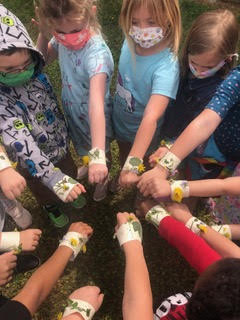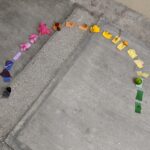Garden Exploration Activities
Nature Bracelets (adapted from Life Lab)

This is a great introduction to the garden classroom, it allows students time to explore and see the garden area while staying focused on a task. Each student is given a piece of masking tape long enough to go around their wrist to form a bracelet. I like using the wide blue or green painter’s tape. Students can help each other create a bracelet from the tape (sticky side out). Students are then given time to explore the garden area and create their own nature bracelet. It is a good practice to use the rule of 10, if there are more than 10 of an object they can pick it, if not leave it for others to enjoy. Each student’s bracelet will be a unique expression of them. It is also easy to incorporate curriculum into this activity. Students can make a bracelet using a pattern, living and nonliving things, textures, etc. This activity is also perfect to do throughout the year to observe how the garden changes with the seasons.
Rainbow Chips
The outdoors are full of vibrant colors but we don’t always take the time to look closely at just how colorful a single leaf or petal or rock can be. Rainbow chips help us to explore the depth of color all around us. It’s an activity that can take 5 minutes or 20 depending on how much time you and your kids take in looking for different colors. The only material needed for this activity are paint samples or other color chips. Read the Life Lab activity guide here.

Six of One, Half Dozen of the Other
Sound Mapping (from Sharing Nature)
Go and See (adapted from Life Lab)
This is a great game for using observational skills and moving from place to place. One person volunteers to move ahead while the rest of the group counts down from 10; when the group gets to 0, the volunteer stops, looks around, and finds something special or interesting to share with the rest of the group. When they have found what they want to share, they give the group a thumbs-up, and the group moves forward to join them. Lead the group in asking, “What did you find?” Let the volunteer point it out and share anything they want to say about it. Ideas include: What do you notice about it? What do you wonder about it? When discussion about their find has concluded, the next person takes a turn, until everyone who wants a turn has had one, or you’ve reached your destination.
Live in the Moment (adapted from Life Lab)
Find a place with a variety of things to see, near and far. Ask your kids to slowly turn in a circle, noticing everything they can see, near and far. Ask them to look at you when they are done noticing. When everyone is ready, ask them to close their eyes. Then ask them to point to some things they might have noticed with their eyes, and also to some things they can notice with their other senses. Keep reminding them to keep their eyes closed. For example:
- With your eyes still closed, point to where you might have seen a tractor
- With your eyes still closed, point to where you might have seen some yellow flowers
- With your eyes still closed, point to where you feel the sun coming from
- With your eyes still closed, point to the tallest trees around
- With your eyes still closed, point to where you hear some birds (or people, or cars)
- With your eyes still closed, point to where you might have seen a whole lot of water (if there is a nearby body of water)
- With your eyes still closed, point to where you feel the breeze coming from
And anything else of note that they could have seen that day.
Ask them to open their eyes and turn in a circle again, noticing anything they might have missed the first time.